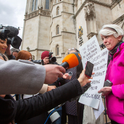In 2023, Melissa, then 27, became a surrogate for a couple she thought would be her friends for life. But six months after the birth, the “intended parents” (IPs) of the baby cut Melissa off. “They blocked me on all forms of social media and sent me a text asking me not to contact them directly again,” she says. “There was no face-to-face meeting or goodbye.”
In the surrogacy contract she signed, Melissa and the IPs agreed that “after the birth all parties will maintain contact” and that Melissa could “if she so wishes, write letters/provide photographs of her and her family for the child.” However, given surrogacy arrangements in the UK are not enforceable in court, Melissa had no right to contest the couple’s decision to cut her out of their lives. “I was more disappointed because they had become very good friends of mine. I offered to carry another baby for them in the future at some point,” Melissa says.
Melissa recalls first considering surrogacy while watching a television program about fertility. With several friends and family members who had struggled to get pregnant for various reasons, she felt a strong emotional connection to the issue. Melissa decided to use her “luck” to help others who were struggling to build a family of their own. “I think in a world where, a lot of the time, all of our time is focused on earning money, our careers and jobs etc, it’s nice to be in a position where you can do something to help other people that’s nothing to do with yourself,” she explained.
This was Melissa’s first time being pregnant, and she was a “traditional surrogate”, meaning she used her own egg for the pregnancy and was therefore the biological mother of the child. She chose this as opposed to “gestational surrogacy”, where an embryo is simply implanted into the surrogate and she is not biologically related to it. When I asked Melissa to clarify that the man in the heterosexual couple she helped was the father, she said: “As far as I was aware whilst doing home inseminations, it was the intended father’s sperm being used. However, this can never be proven for definite as there was no third-party involvement from a clinic.” Informal home inseminations, like the one Melissa used, typically involve using a syringe to deposit sperm directly into the vagina.
In Melissa’s case, she chose not to push back when her IPs cut off contact—even though, at the time, she was still the child’s legal mother. Had Melissa wanted to retaliate against her IPs, she could have refused to hand over the baby and retained the parental rights automatically assigned to her as the birth mother under English and Welsh law.
Although surrogacy is legal in the UK, surrogacy agreements hold no weight under the law. In other words, any forms signed by the surrogate and IPs are not recognised in court and cannot be legally enforced. This means either party can pull out at any time until a court issues a parental order transferring parental rights from the birth mother and her spouse if she has one—who receive them at birth—to the intended parents.
Court battles between surrogates and intended parents over parental rights are rare, but for those who do face them, the experience can be emotionally devastating. With surrogacy growing by an estimated 350 per cent over the past decade, the potential for disputes is rising, making it increasingly urgent for the law to provide clearer and more consistent protections. Melissa chose not to disrupt the surrogacy arrangement and claim parental rights, allowing things to proceed smoothly for her IPs. The law offered her no protection when they broke the surrogacy contract and severed contact, however. Likewise, it would not have safeguarded them had she decided to challenge the agreement.
The practice of surrogacy has long been contentious, both nationally and internationally. The UK’s “altruistic” model was first established by the Surrogacy Arrangements Act in 1985, making it illegal to pay a surrogate beyond “reasonable expenses” and illegal to advertise surrogacy. The scrutiny of payments to verify that the surrogacy is not commercially motivated is the only element of surrogacy law enforceable by English and Welsh courts.
Currently, the surrogate is registered as the child’s legal parent at birth; if they are married, their spouse will be the child’s second parent. The Human Fertilisation and Embryology Act of 1990 established a legal process for transferring legal parenthood by a “parental order” after the child is born, and in 2008, this process became accessible to same-sex and unmarried couples. If there is a disagreement about who the child’s legal parents should be, then the courts deal with this on a case-by-case basis.
In 1997, the Labour government commissioned the Brazier Report, which called for a clear legal framework to regulate altruistic surrogacy ethically and prevent exploitation, but its recommendations were never fully enacted. In June 2019, the Law Commission proposed a series of legal reforms. Central to the changes is a “new pathway” legally enacting the surrogacy agreement at birth by granting intended parents legal parenthood while still allowing the surrogate chances to contest and apply for parental rights. This would legally enforce the surrogacy agreement at birth while retaining the surrogate’s bodily autonomy.
But six years on, no legal reforms have been achieved. The government’s reluctance to legislate on surrogacy has left the practice in a legal grey zone, unregulated and unenforceable. This means individuals enter “altruistically” into surrogacy contracts, but at any moment either the surrogate or intended parents can withdraw, leaving the child caught in the crossfire.
Surrogacy organisations in the UK have attempted to step in where legal regulations fall short, offering counselling, screening, and structured procedures to prevent disputes between surrogates and intended parents. But membership of these organisations is expensive. As a result, many turn to independent arrangements—like Melissa’s—finding surrogates or IPs on Facebook who will be artificially inseminated at home, without the involvement of mediators or formal regulation.
Melissa argues the only real difference is cost. Agencies charge steep fees for services she believes she can handle herself. “Surrogacy organisations paint a picture that surrogacy is a complex journey that needs a third party to monitor it. Apart from making surrogacy unaffordable due to the extortionate membership fees, I don’t see what surrogacy organisations offer to IPs or surrogates that people can’t do themselves. Lots of IPs would be unable to afford a surrogacy journey if they had to pay membership fees to an organisation.”
Agency-backed surrogacies hold no more legal weight than independently arranged ones. But advocates for surrogacy organisations insist their oversight and intercession prevent the kind of breakdown that ultimately unravelled Melissa’s long-term arrangement with her IPs.
Kim Cotton was the UK’s first surrogate back in the 1980s, and she now heads surrogacy organisation Cots (Childlessness Overcome Through Surrogacy). She sees independent surrogacy as “cheapskating” and tells me her organisation often has IPs or surrogates come to them after things have broken down within independent surrogacy arrangements.
“A surrogate recently tried to join Cots and match with IPs here,” she says. “When I did a background check, I found out that in a previous surrogacy she arranged independently through Facebook, the IPs said the baby wasn’t biologically related to the intended father. Both the surrogate and the father were white, but the baby was mixed race.” The process of impregnation hadn’t been monitored by an agency in this situation, and the surrogate mother had got pregnant by a different man. The couple were unable to obtain a parental order as they weren’t related to the child—so they had to adopt the child instead, which was not what they had planned. “I didn’t move forward with her application to Cots and let other agencies know about the situation.”
Conflicts over surrogacy often land on the desk of Natalie Sutherland, a surrogacy lawyer at Burgess Mee. Much of her work deals with parental order complications, and she tells me about a couple of instances in which she has acted on behalf of intended parents whose surrogate no longer wants to give up the baby. In the UK, the legal transfer of parenthood from a surrogate to the intended parents can be a prolonged process, creating a limbo period of six-18 months in which the surrogate remains the child’s legal guardian, despite not being the primary caregiver. Crucially, the surrogate’s consent to the parental order is non-negotiable under the law; if she refuses, there is nothing the court can do to give parental responsibility to the IPs.
Sutherland recently worked on a case involving a same-sex male couple in which one partner was both the biological and legal father and the other not. The surrogate was also the biological mother. A falling out between the couple and the surrogate led the surrogate to veto the parental order request. The couple then attempted a step-parent adoption for the non-biological father as adoption rulings, unlike parental orders, can overrule the mother’s wishes if in the best interest of the child. But the adoption didn’t pass, leaving the surrogate as the legal mother and the non-biological father without a legal relationship to the child.
These issues often find a temporary fix; in this case, a Child Arrangements Order, allowing the non-legal father parental responsibility as a caregiver. But it expires when the child turns 18, leaving no legal tie. “What happens if life happens? If they [the couple] split up? If one of them dies? The law is not equipped,” she says.
“These court battles are also an emotionally traumatic experience,” says Sutherland. “For those IPs who do end up in and out of court for the first few months and years of their child’s life, it utterly ruins their first experience of parenthood.”
Melissa chose not to punish the intended parents for violating her surrogacy terms. However, relying on personal temperament and goodwill in matters as profound as childbirth risks complications for both surrogates and intended parents.
The Law Commission’s recommended “new pathway”, granting intended parents legal parenthood while still allowing the surrogate chances to contest, would have ensured, in the case of Sutherland’s clients, that the child would be living with both legal parents. Disputes would still go to court, but as Sutherland notes, that’s inevitable in some cases. At least with the recommendations of the commission, the law offers a stronger safety net for the original agreement under which the child was brought into the world.
However, this “new pathway” only applies to those registered with the Human Fertilisation and Embryology Authority (HFEA)—such as surrogates working with agencies and formal fertility clinics—not to independent arrangements like Melissa’s.
Independent surrogacy is widely discouraged by experts, yet it persists for a simple reason: agency-facilitated surrogacy is costly and out of reach for many. Melissa argues that legal safeguards and support must extend to independent arrangements. She says that lawyers, clinics, and agencies all have “a commercial interest to gain financially”. Independent surrogacy will always exist—and deserves to be protected by the law.












